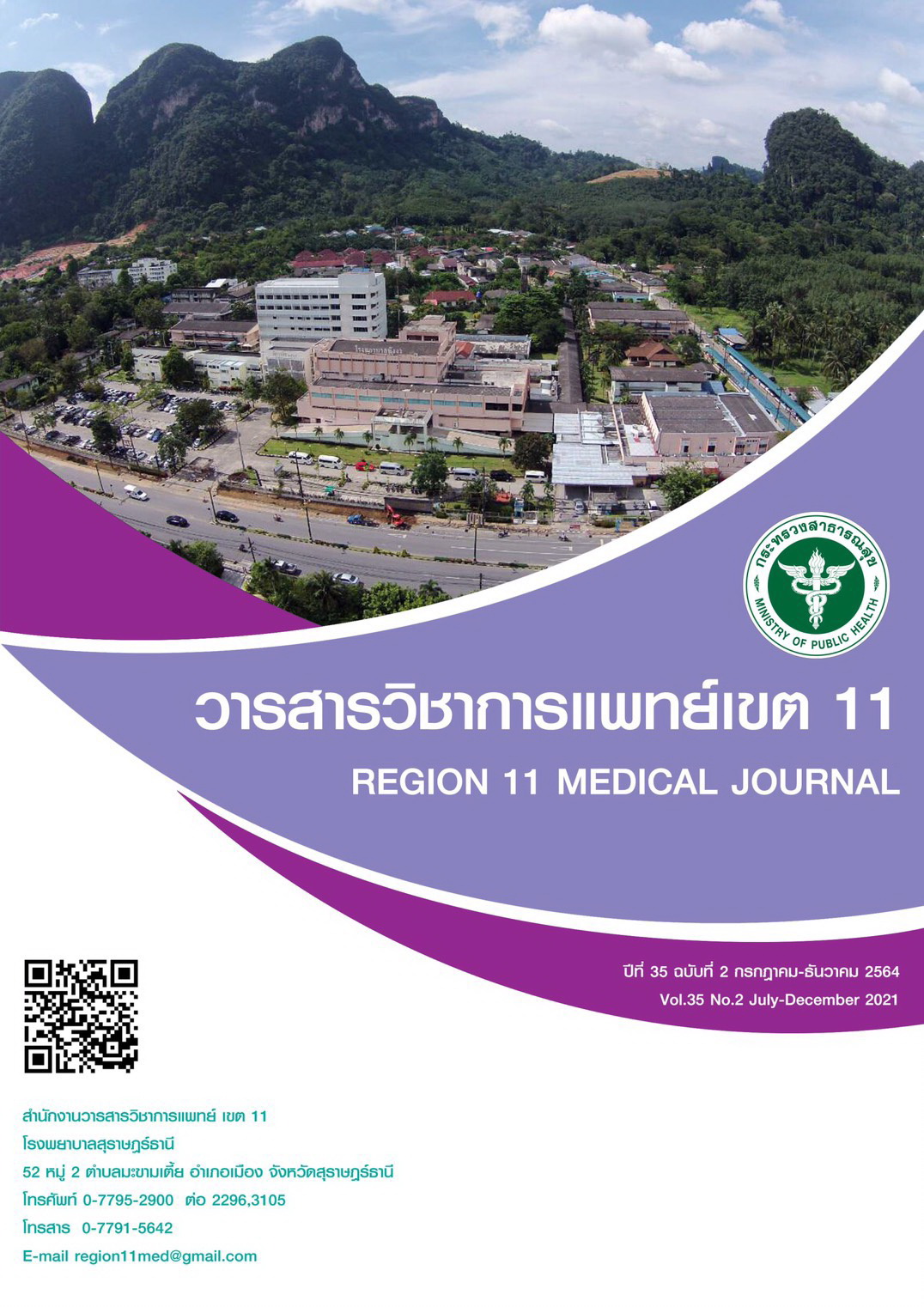Incidence and Related Factors of Joint Contracture in Amputated Side of Amputee at Maharaj Nakhon Si Thammarat Hospital
Keywords:
lower extremity amputee, joint contracture, incidenceAbstract
Background: Amputation surgery is a common therapeutic procedure in clinical practice. This procedure effects permanently on patient’s quality of life. Leg prosthesis usage can improve the patient’s quality of life in ambulation ability. The joint contracture in amputated side is one of important negative factors for prosthesis usage. However, it is preventable.
Objectives: To evaluate the incidence and related factors of joint contracture in the amputated side of lower extremity amputee, Maharaj Nakhon Si Thammarat Hospital.
Method: Retrospective descriptive study research was designed and collected the data of amputees from out-patient rehabilitation medical records.
Results: This study included 153 patients. The patient's average age was 53.86 +15.63 years. The majority of the 113 (73.9 percent) were men. The 150 (98%) were all unilateral leg amputations. Amputations below the knee accounted for 88.5 percent of all amputations. Amputation due to trauma accounts for 53.6 percent of cases, and infection-related amputations account for 26.8 percent. Diabetes mellitus was found to be the underlying disease in 28.8 percent of cases. The incidence of joint contracture in amputated side is 8.5%. The diabetes mellitus was significantly associated with joint contracture in amputated side of lower extremity amputee. (p=0.043)
Conclusion: Diabetes mellitus was discovered to be a risk factor for joint contracture in amputees with amputated lower extremity sides. Health care workers should pay special attention and provide preventable strategies to reduce the incidence of joint contracture while also improving quality of life.
References
Moxey P, Gogalniceanu P, Hinchliffe R, Loftus I, Jones K, Thompson M, et al. Lower extremity amputations—a review of global variability in incidence. Diabetic Medicine. 2011;28(10):1144-53.
Millstein S, Bain D, Hunter G. A review of employment patterns of industrial amputees—factors influencing rehabilitation. Prosthetics and orthotics international. 1985;9(2):69-78.
Sheikh K. Return to work following limb injuries. Occupational Medicine. 1985;35(4):114-7.
Webster JB, Hakimi KN, Williams RM, Turner AP, Norvell DC, Czerniecki JM. Prosthetic fitting, use, and satisfaction following lower-limb amputation: a prospective study. Journal of rehabilitation research and development. 2012;49(10):1453–504.
Nehler MR, Coll JR, Hiatt WR, Regensteiner JG, Schnickel GT, Klenke WA, et al. Functional outcome in a contemporary series of major lower extremity amputations. Journal of vascular surgery. 2003;38(1):7-14.
Roberts TL, Pasquina PF, Nelson VS, Flood KM, Bryant PR, Huang ME. Limb deficiency and prosthetic management. 4. Comorbidities associated with limb loss. Archives of physical medicine and rehabilitation. 2006;87(3):21-7.
Cruz CP, Eidt JF, Capps C, Kirtley L, Moursi MM. Major lower extremity amputations at a Veterans Affairs hospital. The American journal of surgery. 2003;186(5):449-54.
Evans KK, Attinger CE, Al-Attar A, Salgado C, Chu CK, Mardini S, et al. The importance of limb preservation in the diabetic population. Journal of Diabetes and its Complications. 2011;25(4):227-31.
Walsh NE, Bosker G, Santa Maria D. Upper and lower extremity prosthetics. DeLisa's Physical Medicine and Rehabilitation: Principles and Practice: Fifth Edition: Wolters Kluwer Health Adis (ESP); 2012. p. 2017-50.
Lovegreen W, Murphy DP, Stevens PM, Seo YI, Webster JB. Lower limb amputation and gait. Braddom's Physical Medicine and Rehabilitation. Fifth Edition. Philadephia: Elsevier, Inc; 2016. p. 191-224.
Raya MA, Gailey RS, Fiebert IM, Roach KE. Impairment variables predicting activity limitation in individuals with lower limb amputation. Prosthetics and orthotics international. 2010;34(1):73-84.
Munin MC, Espejo-De Guzman MC, Boninger ML, Fitzgerald SG, Penrod LE, Singh J. Predictive factors for successful early prosthetic ambulation among lower-limb amputees. J Rehabil Res Dev. 2001;38(4):379-84.
Meikle B, Devlin M, Garfinkel S. Interruptions to amputee rehabilitation. Archives of physical medicine and rehabilitation. 2002;83(9):1222-8.
Ahmad A, Islam H, Ullah I. A Study to Observe the Incidence of Flexion Contracture at Knee Joint After Below Knee Amputation: JRCRS. 2018; 6 (1): 21-23. Journal Riphah College of Rehabilitation Sciences. 2018;6(1):21-3.
Ghazali M, Abd Razak N, Osman NA, Gholizadeh H, editors. Effect of stump flexion contracture with and without prosthetic alignment intervention towards postural stability among transtibial prosthesis users. IOP Conference Series: Materials Science and Engineering; 2017: IOP Publishing.
Ham R, Cotton L. The rehabilitation process. Limb Amputation: Springer; 1991: p.
-35
James SF, M. Contractures in orthopaedic and neurological conditions: a review of causes and treatment. Disability and rehabilitation. 2001;23(13):549-58.
Jaegers S, Arendzen JH, de Jongh HJ. Changes in hip muscles after above-knee amputation. Clinical orthopaedics and related research. 1995(319):276-84.
Coletta EM. Care of the elderly patient with lower extremity amputation. The Journal of the American Board of Family Practice. 2000;13(1):23-34.
Knetsche RP, Leopold SS, Brage ME. Inpatient management of lower extremity amputations. Foot and ankle clinics. 2001;6(2):229-41.
Ghazali MF, Abd Razak NA, Osman NAA, Gholizadeh H. Awareness, potential factors, and post-amputation care of stump flexion contractures among transtibial amputees. Turkish journal of physical medicine and rehabilitation. 2018;64(3):268-76.
Coletta EM. Care of the elderly patient with lower extremity amputation. The Journal of the American Board Family Practice. 2000;13(1):23–34.
Burgess EM, Zettl J. Immediate postsurgical prosthetics. Ortho & Pros. 1967;21(2):105-12.
Ali MM, Loretz L, Shea A, Poorvu E, Robinson WP, Schanzer A, et al. A contemporary comparative analysis of immediate postoperative prosthesis placement following below-knee amputation. Annals of vascular surgery. 2013;27(8):1146-53.
Pohjolainen T. A clinical evaluation of stumps in lower limb amputees. Prosthetics and orthotics international. 1991;15(3):178-84.
Naschitz J, Lenger R. Why traumatic leg amputees are at increased risk for cardiovascular diseases. QJM: An International Journal of Medicine. 2008;101(4):251-9.
Welty FK, Alfaddagh A, Elajami TK. Targeting inflammation in metabolic syndrome. Translational research. 2016;167(1):257-80.
Zeisberg M, Kalluri R. Cellular mechanisms of tissue fibrosis. 1. Common and organ-specific mechanisms associated with tissue fibrosis. American Journal of Physiology-Cell Physiology. 2013;304(3):C216-C25.






